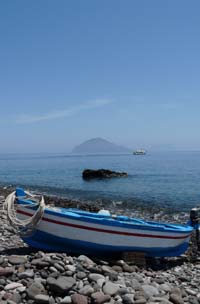
Alicudi is one of seven inhabited islands in the Aeolian Islands archipelago (Isole Eolie or Isole Lipari in Italian), off the coasts of Sicily and mainland Italy. Alicudi is the most remote and has the smallest population of the islands, with its peace broken only by infrequent ferry arrivals, and by the braying of the donkeys which are the island’s mode of transport.
The island is a simple and basic place, with an absolutely unique atmosphere and fewer than 100 inhabitants. Its rugged charm and isolation attract a particular brand of voyager: adventurers, artists, writers and loners looking for some peace to reflect or to work.
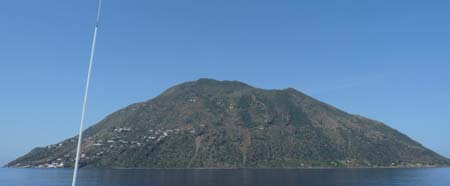
About Alicudi
Alicudi is a large volcanic cone sticking out of the sea; an extinct volcano now covered in vegetation. Footpaths climb steeply up from the little port, passing cultivated terraces and low cuboid island dwellings. The island used to be called Ericusa, named for the heather (Erica) which grows over the slopes. The dwellings on Alicudi, some smart and well-kept, some abandoned, are scattered over the eastern side of the island; the western slopes are steep and inaccessible.
Historically, Alicudi must have been a brutal place to live, with islanders scraping out a living from fishing and from farming the rugged hillside. Many emigrated, and some of their homes were deserted. But, like the other islands, Alicudi’s star has been rising over recent decades. There are now a few holiday homes here, and some money to be made from tourism. The primitive isolation of island life, with no traffic, no noise pollution and few conveniences, has become a selling point for those looking to escape the modern world. There is something magical about Alicudi, but it’s not a fey magic of fairies; rather a tough elemental kind of enchantment.
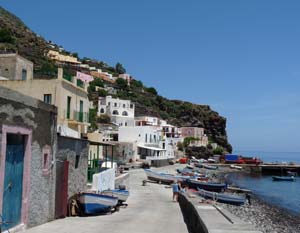
Things to do
Visitors arrive at the island’s tiny port, Alicudi Porto: one jetty for ferries, a line of small boats drawn up on a stony beach and a few curious ducks. This is Alicudi’s hub of civilisation: the island’s scarce services are clustered here. When I visited there were one or two motor vehicles parked by the jetty. Apart from driving onto a ferry they have nowhere to go: there are no roads on the island and goods are transported by donkeys.
You need to be energetic to explore Alicudi. The island’s simple painted dwellings are spread along a network of rough stone mule paths which climb steeply up the sides of the former volcano. The picturesque scenery is a reward for the effort, offering small ancient terraced fields, donkeys swishing their tails, flowers growing up walls, views towards Filicudi and cats loafing in the shade. A steep ascent above sea-level, you’ll reach the pale-yellow-painted church of San Bartolo.
It is possible to continue climbing, and to hike right up to the former crater at Alicudi’s summit, Monte Filo dell’Arpa, at 675m above sea level. This is a strenuous walk taking several hours, and you should take water and sun protection. Along the way, as well as more distant views you can appreciate the island’s wildlife, which includes nesting falcons, flowers like cyclamen, orchids and narcissus, and some fugitive sheep under threat from UNESCO.
There are stony stretches of beach along the seashore to the south of the port. In addition to sunbathing, active tourists can enjoy wwimming and diving off the rocky shore. The waters are clean and clear with plenty of fish to interest the nature-lover. You could hire a boat, or take a boat tour around the coastline. Local fishermen go out daily and the seafood eaten on the island is truly fresh. By asking locally, you may be able not merely to hire a boat yourself but perhaps also go out fishing with the local fishermen.
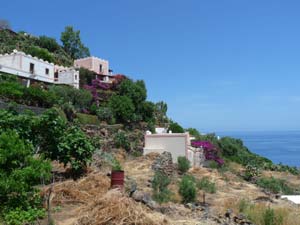
Shops and services
In the last couple of decades Alicudi has been developed to the extent of having running mains water, electricity and telephones. A public payphone stands incongruously on the hillside. There are two small general stores where you can buy refreshments, one by the port and the other along the seashore. This latter is a useful shop concealed behind an anonymous curtained entrance, selling basic imported provisions, and when I visited, a friendly shopkeeper made me a cheese and tomato roll for a picnic lunch. There is one hotel on Alicudi, with a restaurant, and up-to-date guidebooks will point you towards a house where the host will make dinners for visitors. If you are staying on the island you should bring sturdy shoes, a torch and enough cash for your stay, as there’s no cashpoint.
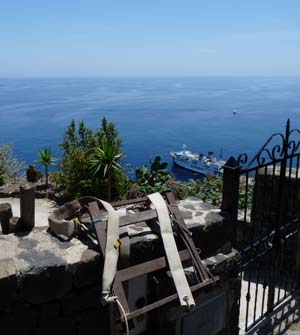
Travel to Alicudi
You can find information on how to get to the Aeolian Islands on my Aeolian Islands homepage. There are scheduled ferry services to Alicudi from the other Aeolian Islands, but you should always check the latest timetables, as they aren’t particularly frequent. In the summer months, Alicudi can be reached by twice-daily Ustica Lines hydrofoil services from Palermo and there’s also one hydrofoil a day from Cefalù in Sicily. Geographically, Alicudi is the nearest of the Aeolian Islands to these ports, as it is to the west of the other islands. It can also be reached by direct services from Milazzo, the main port for the Aeolian Islands, and from Messina in Sicily and Reggio Calabria in mainland Italy.
Alicudi can be visited from the principal Aeolian Islands on boat excursions. These usually combine Alicudi with its relatively cosmopolitan neighbour, Filicudi. Organised excursions are a convenient way of seeing Alicudi, though they do have the disadvantages that your time on the island will be circumscribed, and you will arrive in company with other tourists, rather than being able to explore the island in solitude.
Accommodation
Alicudi is really only an overnight base for real solitude-seekers; those wanting a retreat away from the world. Staying here is an incredible opportunity for getting away from it all in breathtaking surroundings. There’s just one hotel and few small and simple B&Bs and rooms to let. For an atmospheric break, I’d suggest staying at the Giardino dei Carrubi, a really special B&B.
For a more active holiday or to see all the Aeolian Islands, it makes more sense to base yourself centrally, on an island like Lipari with frequent ferry connections, and to visit Alicudi for a day-trip.
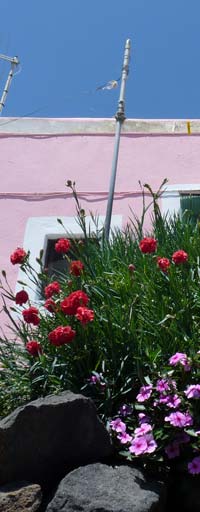
On this site
South to Calabria: a travel itinerary finishing in the Aeolian Islands
Hotels in Italy – what to expect
Useful external links